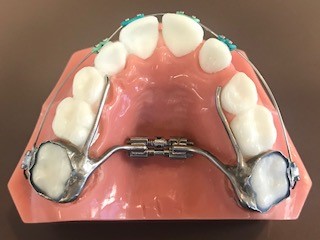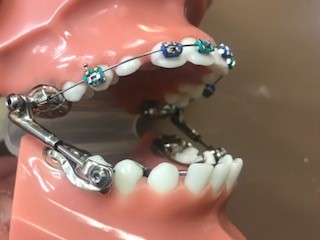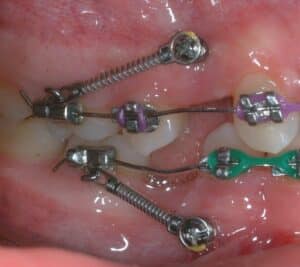Palatal Expander

It is commonly used when the upper jaw is too narrow for the lower jaw and when the upper teeth are crowded or blocked out of the dental arch.
When patients are still growing, their bone and connective tissue between the left and right halves of their upper jaw are very responsive to expansion. The expander is activated with a special key that we provide for the first 2-6 weeks after it is placed, applying gradual outward pressure to widen the upper jaw.
This pressure causes an increased amount of bone to grow between the right and left halves of the jaw, ultimately resulting in an increased width long-term.
When you brush your teeth, it is important to remember to use a Proxabrush (which we provide in the office) in addition to your regular toothbrush. Brush as usual and use warm water to flush under the expander.
Mini-Herbst Appliance

At first appearance, the Mini-Herbst might look like a mouthful! Because the appliance is hidden inside the mouth, however, it appears on the outside no different than braces. In addition, since it is worn continuously, most patients adapt to our Mini-Herbst in only a few days. The Mini-Herbst is usually worn for 8 to 12 months with adjustment appointments every 4-10 weeks.
The great advantage of the Herbst is it works on the lower jaw where most of the correction is usually needed and it works faster and is more predictable than other treatments (for instance headgear) because you don’t have to remember to take it on and off. Our Mini-Herbst will usually result in less overall treatment time compared to similar bite correction methods.
Temporary Anchorage Devices (TADs)

Their function is to provide a stable anchorage — a fixed point around which other things (namely, the teeth) can be moved.
While they are not needed for most of our patients, the use of TADS offers many benefits: We may use them to close spaces for missing teeth or to gain space if needed for a dental implant. They can help us to correct overbites, underbites, deep bites and open bites. They can improve the orthodontic result, shorten overall treatment time and reduce the need to wear elastics (rubber bands) — and in some cases, TADs can allow our patients to avoid jaw (orthognathic) surgery. Using TADs allows Dr. Baumgaertel and Dr. Beckwith to get improved results for complex cases that were not previously obtainable. This small device can really do a big job!
Schedule your free complimentary consultation visit with our team at Mountain View Orthodontics to see if your orthodontic treatment might benefit from the use of TADs.